In the 1950s, artwork of what the future would look like included flying cars and streamlined buildings reaching for the sky. In the 60s we were heading for the Moon. When digital watches came along in the 70s, it seemed like a natural step away from rotating mechanical hands to space age, electrically written digits in futuristic script.
But little did we know that digital watches had existed before and that our interest in digital watches would fade only to be reborn in the age of smartphones.
Mechanical Digital Watches
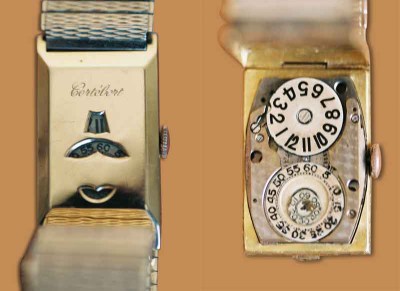
Image by Wallstonekraft CC-BY-SA 3.0
In 1883, Austrian inventor Josef Pallweber patented his idea for a jumping hour mechanism. At precisely the change of the hour, a dial containing the digits from 1 to 12 rapidly rotates to display the next hour. It does so suddenly and without any bounce, hence the term “jump hour”. He licensed the mechanism to a number of watchmakers who used it in their pocket watches. In the 1920s it appeared in wristwatches as well. The minute was indicated either by a regular minute hand or a dial with digits on it visible through a window as shown here in a wristwatch by Swiss watchmaker, Cortébert.
The jump hour became popular worldwide but was manufactured only for a short period of time due to the complexity of its production. It’s still manufactured today but for very expensive watches, sometimes with a limited edition run.
The modern digital watch, however, started from an unlikely source, the classic movie 2001: A Space Odyssey.
The Watch Inspired By 2001: A Space Odyssey
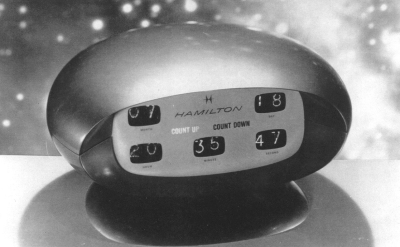 The next era of digital watches came in 1966 when Stanley Kubrick hired Hamilton Watch Company in Lancaster, Pennsylvania to make a futuristic clock for his upcoming movie, 2001: A Space Odyssey. The resulting clock was shaped like a squashed sphere and displayed time using digits from small Nixie tubes.
The next era of digital watches came in 1966 when Stanley Kubrick hired Hamilton Watch Company in Lancaster, Pennsylvania to make a futuristic clock for his upcoming movie, 2001: A Space Odyssey. The resulting clock was shaped like a squashed sphere and displayed time using digits from small Nixie tubes.
The clock never made it into the movie but it inspired its makers, John M. Bergey and Richard S. Walton, to work on a digital watch. They’d also worked together in Hamilton’s Military Division on an electronically timed fuse, technology which they’d thought about applying to watches and clocks.
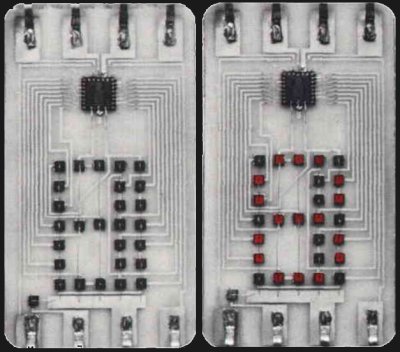
Meanwhile, also in 1966, George H. Thiess founded a company in Texas called Electro/Data which produced solid-state microwave components and subsystems. Thiess had a dream of developing an accurate watch and devoted a small portion of the company’s resources to the project. After making a few prototype clocks as research for developing the watch, they hired Willie Crabtree from Texas Instruments to work on it as a project engineer and by 1969, had a prototype clock which used the new HP 5082-7000 LED module (PDF) for the digits.
By this time, Hamilton had also developed a digital clock but lacked the resources to scale it down to a watch. They contacted Electro/Data and by December 1969, the companies had an agreement to work on a digital watch together.
The watch they’d come up with was called Pulsar, named for the type of star which sweeps a beam of electromagnetic radiation across space at a precise rate of rotation.
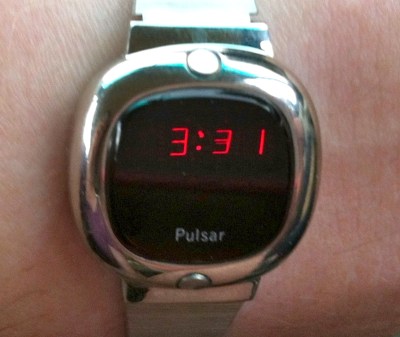
Photo by Alison Cassidy CC-BY-SA 3.0
By April 4th, 1972 they had a limited edition of 400 18-carat gold Pulsar watches selling for $2,100 — $12,500 in 2018 dollars. The watch used a quartz crystal for counting time and red LED’s for the display. To save power, the time was not always displayed. Instead, you’d press a button which would show the time for just over a second and if you continued to press, the display would change to show the seconds counting up.
However, there were problems with the 44-IC main computing module supplied by Electro/Data resulting in a recall. Eventually, Hamilton ended up making their own. There were also battery issues with the first watch, leading to the use of 2 specially made silver-oxide button cells, expected to last for a year of up to 25 readouts a day.
By 1975 some Pulsar models were selling for under $300 ($1400 today). At the peak, 150,000 were sold in 1976, but by then electronics companies were selling their own for under $100 ($450) and in 1977 they sold only 10,000.
Enter The Cheap LCD Watches

The state-of-the-art for LCDs in the 1960s required a constant current, a voltage which was too high for batteries, and a mirror which limited the viewing angle. All that changed in the early 1970s with the TN-effect (Twisted Nematic field effect) which requires low voltage, low power, and no mirror.
By 1972, four-digit watches using these new low-power LCDs hit the market, and six-digits followed from Seiko in 1973. Even Intel got involved through a watch company they’d bought called Microma. Unlike the more power-hungry LED watches, these LCD ones could be always on, though often pressing a button turned on a small light for reading the digits in the dark.
Casio and Texas Instruments entered the market, producing large quantities. In 1976, Texas Instruments sold 18 million alone and soon the price fell below $20. Eventually, TI introduced one with a plastic watchband for just $9.95. As you’d expect, numerous companies weren’t able to compete and either stopped producing digital watches or closed down.
Smartwatches In The 1970s and 80s
It may surprise many to learn that smartwatches are not a new thing. The very first digital watch, the Pulsar, was thought of by its makers as a time computer and Hamilton’s subsidiary for making them was called Time Computer, Inc. They even released a limited edition 18 carat gold Pulsar with a built-in calculator selling for $3,500 with plans for a $600 stainless steel one. But it was in the 1980s that addons really hit the market.
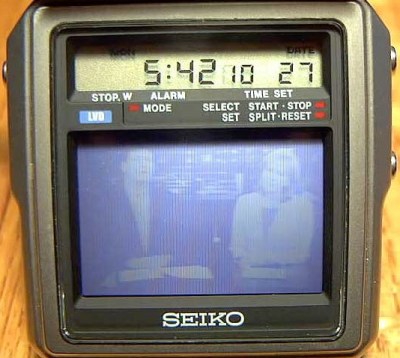
Seiko came out with a TV watch. The TV display used a transflective LCD which worked with external light, the brighter the better. To watch TV, you plugged it into a receiver which fit in a pocket. The cable going to the headphones doubled as an antenna.
Casio produced a variety of watches with different features such as a built-in calculator, a thermometer, one with a 1,500-word dictionary for Japanese-to-English translation, and even one which could dial your home phone number. Citizen had one with voice control, and both Seiko and Timex released wristwatches which interfaced with computers.
But advancements in commercial digital watches had peaked. After this point most just told the time and date. That is until mobile phones came along.
Mobile Phones Killed The Watch
Mobile phones have displayed the time ever since their early days, bringing on a brief era when many wrists went bare. As watches wore out or broke there was no need to buy new ones. Younger generations grew up with mobile phones and had never even worn watches, neither analog nor digital.
Only folks who’d worn them all their lives had watches, or as in my case, had one which cost more to repair than the watch itself but kept it going for sentimental reasons. It seemed for a while as though the watch would eventually die out altogether.
The Rebirth Of The Watch
While mobile phones, and especially in their modern form, the smartphone, seemingly killed the watch, they were also partly responsible for its rebirth as the modern smartwatch.
One reason for the rebirth is that to look at a text message which just arrived or to check the time on a smartphone, you have to pull it out of a pocket or pick it up off a table. In a meeting, it’s less conspicuous to just twist your wrist and glance at something there. On a bicycle, there’s no need to stop and haul out a phone to check if a text message requires attention when a quick glance at your wrist will do.
Another reason is that smartphones brought on advancements in technology which were also useful for watches. Those include more robust glass, better touchscreens, displays, and operating systems for small devices.

Image by Romazur CC-BY-SA 4.0
As with a lot of new products, a few modern smartwatches appeared but they didn’t really take off until the Pebble came along in 2012. Pebble raised a record $10.3 million on Kickstarter, showing that there was a sizeable market. It had a black and white ultra-low-power transflective LCD with a backlight, vibrator, accelerometer, and a battery life between four and seven days. There were over 1,000 apps on the pebble app store and it could communicate with a smartphone for that convenient glance to see why your smartphone is ringing. Unfortunately, the Pebble ceased production in 2016 when the company was bought by Fitbit for its IP.
Pebble’s success spurred on the introduction of many more smartwatches but the most notable was the Apple Watch in 2014, even though its main effect was arguably that it introduced more consumers to the market.
The jury’s still out on just how ubiquitous the smartwatch will become. For many, checking the time on a smartphone will remain the way while niches will continue to exist such as wrist-mounted health monitors. There does seem to be a resurgence in the number of people wearing analog watches, perhaps as the low tech alternative to hauling out a smartphone to check the time or because they’ve simply become fashionable again.
As someone who wore an analog watch for almost 50 years (except for the 70s when I wore a digital one), I stopped wearing my beloved Cardinal when the strap last broke and now use my smartphone when I’m away from the computer. Did you use a digital watch back in the day? Or perhaps you had one with a calculator? Or was a smartwatch your introduction to the digitized wrist? This being Hackaday, we’re of course expecting a few of the answers to be a DIY smartwatch, like this wooden one, or maybe a hacked Pebble.















Hold my beer and watch this..
Words to live by..
Yeah, I owned the TI LED watch, and gladly replaced it with their LCD watch when it came out.
It was replaced by a Senor Tri-Lite LCD, which was backlit by a tritium capsule, but the tritium has since gone through 3 half lifes since then.
s/Senor/Sensor
I had one, too. Stainless steel, just like the Pulsar, only much less expensive.
Wish I still had it…the red crystal cracked and the button stopped working, so I think I junked it.
The best part of the early LCD watches was that they didn’t need batteries!
(The displays were so poor, you couldn’t tell if they were on or not; so why replace the battery?)
I had a TI LED watch. It was sort of annoying to have to press the button to get the time, in particular if you were driving.When the strap broke I took to a bench sander and made it into a pocket watch.
I later ended up with a Casio calculator watch my wife got me for a birthday present.
Far out in the uncharted backwaters of the unfashionable end of the western spiral arm of the Galaxy lies a small unregarded yellow sun. Orbiting this at a distance of roughly ninety-two million miles is an utterly insignificant little blue green planet whose ape-descended life forms are so amazingly primitive that they still think digital watches are a pretty neat idea
And so they are (a pretty neat idea)
Updated for this spacetime… “…that they still think smartwatches are a pretty neat idea.”
I still think so ( George h thiess )
I rocked a Casio calculator watch back in the early 90’s. Had a nice analog watch in the mid 00’s. Hadn’t worn a watch again till work issues me an iPhone 7 and I found myself missing notifications constantly due to the anemic nature of the new vibrating notifications. That prompted the purchase of an Apple Watch, as it’s much more difficult to miss something tapping on your wrist than buzzing anemically in your pocket. I’m one of those weird people who hates audible alerts from their devices, so it works for me :)
I had a friend that had a digital watch in the early ’80’s that placed a bunch of songs.
Well, he had it under another friend placed it in the microwave oven.
B^)
s/under/until
s/placed/played
(This is getting ridiculous!)
Went the same way as those car horns that play music.
And why didn’t the first friend made the second one to replace the destroyed property? At any cost of course.
Second friend replaced the watch with a Casio Data Bank or something like that, it was quieter, therefore, less aggravating.
B^)
Guessing that was a Casio Melody Alarm… I really dig mine, and the way I can use it to stop my 15mo son from being sooky and difficult. It also has a completely unique stopwatch, which becomes a timer when you hit the adjust button. Best part is how it starts the stopwatch when the timer runs out, and then beeps every minute! If you want a shock, have a look how much these are going for these days.
I had the same Casio calculator watch. I loved that thing. I only wore it during math exams. Ever since then I’ve been using my phone. I have a Rolex but I never wear it.
I have a Fauxlex and never wear it either.
That I would be wearing such an expensive watch is a dead giveaway that it is fake!
B)
This comes several paragraphs after you first mention the Pulsar…
“It may surprise many to learn that smartwatches are not a new thing. The very first digital watch, the Pulsar, was thought of by its makers as a time computer and Hamilton’s subsidiary for making them was called Time Computer, Inc. They even released a limited edition 18 carat gold Pulsar with a built-in calculator selling for $3,500 with plans for a $600 stainless steel one.”
Was that an edit placed by The Department of Redundancy Department?
Nope, intentional. They came out with the first electronic digital watch which just told time and so began that era. Then they came out with one which also had a calculator and so began the smartwatch era. The mentions belonged in two separate sections in the article.
However, I did do a search for LCD during proofing to make sure I didn’t write LCD display anywhere.
Love my “Pebble time”. Water proof, shows phone alerts(fully configurable), custom animated face and only needs charging once a week. Most everyone I show it to says “Wow, you have an Apple watch” and then I explain it is Pebble and they are like “where can I get one..?”
Who will be the first to make a 2001 nixie clock?
Someone please do, and submit to the tips line so we don’t miss it! A post is in the works which might help with that – a gem and a mystery which I found while researching this article.
Where did you find that picture of the 2001 clock?
And I wonder: how do movie prop makers make a shell like that? They couldn’t be spending the money on injection molding. Whatever they do, it might be good knowledge to have in the maker community.
The picture just kept coming up during research. Looks like it might have been a marketing photo.
I wonder if it has a fiberglass shell.
Back in the 1960’s, that was the easiest way to do it.
Then again, automakers are pretty good at making mockups using clay.
Then again, after a decade of molding tail fins, Detroit probably had lots of people able shape that clock case!
B^)
It could have been fiberglass, bondo, clay, or a modified case for an existing product. Prop makers have been very creative for a long time.
My first guess would have been vacuforming, but I don’t know how common that was at the time. Second guess would be a mock-up in bondo or clay, then either covering the mock-up in fiberglass or sending the mock-up to a metal shop. The things people can make with just a small hammer and an english wheel are amazing.
Now days, I would think a printed model, then metal forming like mentioned here back in https://hackaday.com/2017/10/20/low-budget-hydroformer-puts-the-squeeze-on-sheet-metal-parts/ . Or covering a printed model with the same bondo or fiberglass and polishing smooth. And now I think I need to add this to my wish list of project ideas.
Well, it won’t be Nixies, but this article is inspiring me to get to building a clock using my HP hexadecimal LED’s.
Lixies appear to be the alternative.
https://spectrum.ieee.org/geek-life/hands-on/build-a-clock-with-lixies-the-nixietube-lookalike
I like LEDs much more than this old fashioned neon glow of the nixies with their staggered placement of the digits.
I still have a Pebble, and despite the fact I don’t wear watches often, the Pebble always impressed me.
Pissed me the hell off when FitBit bought then, stripped them, and dumped the carcass on the side of the road.
Welcome to the ugly side of competitive technology: Buying a competing company just to get rid of a better product rather than actually making a better product. “Dilbert” is a documentary, after all.
I have a Lowrance aircraft GPS sitting at home that went the same way.
I have all the Pebble versions, except the Pebble 2. I wear a Pebble every day, either a Pebble Time or a Pebble Time Round. Actually lately only the Pebble Time Round, I just love the size. I do hate the battery life, but the fact that it only takes 20 minutes to fully charge does make up for it.
The Pebble Time goes on the wrist if I have to travel.
I agree. I will never buy a FitBit watch, ever. If we support such unethical behaviour from companies, we fsck-up our own future.
https://store.repebble.com/ !
likewise I love my pebble though the battery only lasts a few days now and the display often needs tweeking to keep it readable but when it works its great :)
Back in the 1970s when I first saw digital (LED) watches while on vacation in Bordeaux, France, I thought digital watches were a pretty neat idea. And I still do (thanks Douglas Adams). Unfortunately I seem to be in the minority. In the 1980s, everyone started wearing LCD digital watches.
But then between the mid 1990s and now, the Big Dumb happened (where we no longer expected people to learn to use new technology, but instead, technology started catering to dumber people), and now everyone is using stupider computers and operating systems, stupider phones, and analog watches.
If we keep going this way, we’ll never switch to 10 hours of 100 minutes of 100 seconds per day. ;-)
===Jac
World was better when we did this. LOAD “A?C”,8 Geeks Rulz! :-p
I remember the “?” as wildcard, but still don’t know what A?C was.
I saw the LED watch on the wrist of a neighbor when I was a child – and wanted one. So I was a little disappointed when I got an LCD one, because it did not have the nice red digits. Of course the longer battery lifetime was a big advantage.
And so I am used to a digital watch since the age of 12. For some time I also had a calculator watch in the 80ie, but once I forgot to take it off before jumping in the pool…
I do not accept the backstep to the pocket watch (using the phone instead of a proper wristwatch) and do not like analog watches.
Now I have a Casio with temperature, compass and barometer and a solar cell to charge it’s battery – and 5 bar water resistant, so a jump into the pool (or lake) is no danger.
I had a Timex with an electronic compass.
The instructions said to find your local magnetic deviation before setting it. (I think it is 4 degrees East)
Once I went through the setting process, (something like; stand in a field away from metal objects, know where True North is, push a button, spin around a couple times…blah, bla, bla..)
Then I read the specs, and it was good to only about 12 degrees…
The Timex finally died, its rubber seal had stretched, no longer forming a water tight seal, sweat from hard work ran down my arm, got inside it and…you know the rest.
I really like the HaD illustrations, are they complied somewhere ?
Not really a compilation but go to
https://hackaday.com/category/curated/original-art/ They’re by our awesome art director, Joe Kim.
Marvelous! Thanks a lot!
Could be nice to make a gallery, on hackaday.io for example.
Anyway, bravo Joe Kim !
https://hackaday.com/category/curated/original-art/
I had a regular watch as a timekeeper, then got a cellphone, but it was kinda big and awkward to whip out every time I wanted to see the time so I kept the watch. Then I got a smaller candybar phone that fit neatly in the pants pocket and was easy to get out, and the watch kept breaking down so I just stopped wearing the watch.
Then I got a smartphone, and while it was slimmer so it could fit the same pocket, it was no longer easy to just slip it in and out of the pocket for its size and shape, and now you had to push a button to wake up the screen. As it happens I got an interesting old soviet watch as a gift, so I cleaned and fixed that and now I’m back to wearing one.
Didn’t the Soviet watches stop running in 1991?
B^)
In Soviet Russia, [and everywhere else too these days] the watches, they watch you…
B^)
Yes, but mine has a japanese movement
In the future you’ll query your implant for the time.
One of my memories of reading “Neuromancer”.
I use a Vostok Komandirsk as a daily watch, among others, I also have a Ruhla (DDR), but not the Ruhla Jump Hour I had as a kid, that one is long gone, it was the fake satin band that broke, and then it ended up in a junk drawer.
I had lots of Russian/DDR watches as a kid (Sweden had som trade agreement I think), they were just as bad as you think, but now I have become Ostalgic and started to miss the little bastards, so many hours late night Ebaying later, I have a few again.
I find the idea of using the phone for the time quite stupid. It’s worse than the backlash to the pocketwatch, as you additionally have to activate the screen. I want to see the time at a glance on my wristwatch.
Still looking for a functional, affordable HP-01. That does not seem to be a valid combination, though.
Ahh! I see the problem! You want “affordable”.
B^)
In the early 1980’s I saw an LED calculator watch in a jewelers window.
Unlike others, it had a circular face with the buttons circling the display.
I recall one of the buttons was for square root.
He wanted $200 for it, which was way too much for me, and I haven’t seen one like it since.
I had one in gold.(real gold, not just gold plated) Citizen made them and having relatives in the jewelry business I ordered on in 1977 for $300 dollars. It came with a small pen looking device designed to make it easier to push the tiny buttons around the bezel. I used it all the time. I cracked the screen on it and sent it in for repair. It was lost in the mail never to be seen again. The empty box was found by the postal service many months later but by the time that showed up I had thrown out my postal insurance slip for it. Even though they had the insurance information on the package they would not honor it without the receipt slip. I was and still am ticked off about that!
I think you’ve nailed it, it is just that all the Citizen calculator watches I see while searching the Net are LCD. But they look similar to the one I recall. What also stood out for me is that it was an LED watch, and I saw it when LCD was already in general use.
My Citizen had an lcd display but it did have a bright backlight button.
I wish SwissMicros would make an HP-01 clone.
https://www.swissmicros.com/index.php
Nice, although the most important quality for any calculator is getting the math right every time. Hope the QC is up to that.
The website says their 15 clone, does NOT have the bugs found in the original HP15C!
The bugs were not in the original 15C. They were in the 15C LE, a limited edition re-creation of the 15C that HP released in 2011.
Don’t be like Windows Calculator where if you get the square root of 4 it displays 2, but multiply that by itself you *do not get 4*.
Set the way back machine to stun..
Back in the 1980s, I bought a digital watch at the “Swap Meet” for $1.00 USD.
I thought it was a great deal, until I was in a staff meeting the next day, and the alarm started chirping and would not quit..
I took it off and tossed it outside to shut it up..
I’ve seen a couple of master/slave clocks on Hackaday, and how they can be salvaged and adapted to work without their master clock (they are missing here, but that’s still a great article).
The “jump minute” style slave clocks are very common in European train stations.
They are mostly synchronized using a 50Hz motor, the seconds needle runs its cycle in 59s, and waits for a pulse coming from a master clock, allowing it to continue another cycle and moving the minutes/hours needles.
SBB’s jump minute clock: https://www.youtube.com/watch?v=fGRJWl48b7w
Before automatized train dispatching, the train controllers would blow their whistle right when the clock would stop between the 59 and 00s mark.
The noisy resynchronization of slave clocks after a power loss or DST adjustments is definitely a thing: https://www.youtube.com/watch?v=dwb8RxoOkHA
The Bulova Accutron was the first modern electric watch that I remember. My father sold them in his jewelry store in the early 60’s. They had an electric tuning fork inside to regulate the time. When you put your ear up to them you could hear the tuning fork resonate at it’s high pitch. They had and still do have a cool factor about them!
Yes, and Maxwell Smart pulled the tuning fork out of his watch and used its pitch to shatter a glass barrier during a “Get Smart” episode about Kaos having developed hypnotizing sound.
(Yes, I’m that old…)
Wow, that’s really clever of him. I didn’t think he had those sorts of brains. (Did 99 suggest it to him?)
Agent 99 was with him at the time, so maybe it was her idea.
Then, there were the the self-winding mechanical watches. I still have (and occasionally use) my old Bulova. It winds itself just from your wrist motion. It has analog hands; but also a date window which is digital.
To top that, someone will have to come out with a digital watch that never needs batteries (harvests energy somehow).
Thermal, motion, nuclear, etc.
You forgot the easiest way: solar.
There was once an article here about a Seiko watch that used the mainspring to power an electronic regulator to help it keep accurate time. I wonder if a self-winding mechanism could be used to keep the watch constantly powered.
That would be a Citizen EcoDrive. Solar cells in the face. I have 3 or 4. Works as long as it gets some light every day or two.
Also have a vintage 1921 chronograph (stopwatch) style watch. Pretty early in the development of such. Purchase price was 1/3 of the cost to make it work again. Had to go to an actual watchmaker, not just repair shop, as several replacement parts had to be made, most notably the leather(!) clutch for the stopwatch.
I have one of those too, put it away for a while, and it got the erratic movement of death, so now it is sitting in a window between uses.
No problem at all: I have one since probably more than a decade. The outer part of it’s frontglass has a thin film solar cell, a ring approx. 4mm wide at the edge. This recharges it’s battery quite nice. You just should not use the auto-light function in winter. In this mode it activates the light with the motion of the wrist when you look at it. When you do certain motions like dancing or change the spark plugs in your car :-) then it activates so often, that the battery runs low. Especially in winter when there is low light and you wear long sleeves all the time beeing outside it’s best to deactivate that function.
I still wear a wrist watch, because for me my phone is effectively a pocket watch, since I have to drag it out of my pocket to check the time, and hold it just right to view it because of the Sun.
Like a sundial!
B^)
Those who say the phone made the wristwatch obsolete don’t realize the wristwatch was invented to replace pocket watches.
I always found wristwatches uncomfortable so had a pocketwatch right up until cellphones became a practical pocket-sized item. I guess you could also say that cellphones made pocketwatches obsolete!
At the time, I also had to do a lot of math in the freezing cold/rain so had a slide rule. The departmental GPS wasn’t very good, so I had a compass. We had bows & arrows with rope to climb trees. Biology is a fun science sometimes!
I just find it uncomfortable for sleeping. So I take it off at night. I think it’s well accepted, that wristwatches made the pocketwatch obsolete. :-)
Exactly!
A couple of LCD watches to be on the lookout for are the two models of Casio touchscreen calculator watches. One has a virtual keyboard, the other one you draw the numbers and operators on its face, over the analog hands – LCD is above the hands. I found one of the keyboard style for 50 cents at a thrift store, sold it for $50 on eBay.
The gotcha on them is the digitizers are not robust. A bit of a scratch will kill them. Definitely not for the person who smacks a watch into doorjambs while walking through. Collectors only want them in working order.
https://www.youtube.com/watch?v=piFaJmYpQfQ
A version of me with a lot more hair used to work with animals held in pens and outbuildings with stone walls. You learn fairly quickly to wear a wristwatch with the movement on the inside of your wrist and the strap/buckle on the outside. Also works very well with the “Hold my beer …what time is it?” routine.
The problem with digital watches is that they’ve never been stylish/elegant. That was okay back in the eighties when their design could at least be considered as being futuristic, but nowadays their clumsy design is neither futuristic nor stylish. I’m a great fan of digital watches because I like reading the time in digital format (I don’t like “translating” the position of the hands in a time value), but I’m always getting a little bit frustrated about digital watches being so plain ugly. All those Timex, Casio and even Nixon watches lack style – especially when compared to handcrafted analog watches. And forget about those smartwatches too; some of them look nice (especially with custom watch faces), but I don’t like wearing a watch which has to be recharged at least once a week. I even had to buy a muslim prayer watch (although I’m not a muslim and not even religious at all) to get a halfway stylish digital wristwatch; this is a shame that despite all progress made in LC technology, one can’t barely find digital watches which combine practical use and style/elegance…
Same here for reading time :) For me, natural format of time is not “quarter past five” but “seventeen colon fifteen” and an analog clock would be less practical than a digital one. It’s a matter of habit.
That’s interesting. I recall when I first switched from analog to digital, thinking how natural it was to read time as hour:minutes. But now that you bring it up, let’s say you had to be somewhere at 3 o’clock and it’s currently 25 minutes to 3 for example, the volume of space which the minute hand has to traverse until it points to the 12 represents how much time it left. As the minute hand moves and that volume decreases, I get a feeling of decreasing time. It’s intuitive in a different way.
Yes and no. I want to know how many minutes I have left, not only that the time is decreasing. That fact is clear anyway. And I can calvculate this much better from numbers than from a moving hand, often on a watchface without numbers :-(
I agree so much, most digital watches are really ugly or at the very least lacking style, and that’s very annoying for someone who prefers digital.
I think the new ‘smart’ watches with their software changeable watch-faces did give some possibilities to move things along though, but I fear the smartwatch trend is going in other directions now where it’s more about fitness and people are losings interest in the actual looks of it leading to a halt of development in the design area.
On the subject of ugly watches, I’m forever perplexed why companies like Casio HAVE to have all that silly text on them, and refuse to make things look less awful by doing away with that, for decades and decades and decades.
Same for me: “Time is a number, not an angle”.
But for me it’s quite unimportant, how the watch looks. Ok, it should not look like 1 $ plastic toy. More important are functions, like compass, temp, altitude. And good water resistance and self charging (solar).
I’m opposite to Yvan, above.
I by far prefer to check the time using an analogue watch. I don’t have to translate the numbers to get the time, I seem to infer the time from the finger positions!
The watch on my wrist has been there for 25 years plus and iirc it’s on it’s 3rd set of batteries. OK it doesn’t let me know when a mail or text has arrived, but I do not feel the need to be a slave to my phone.
I much prefer digital for telling time, but it’s impossible to argue that there isn’t something real elegant and nice about a well-designed analog watch.
I always lived with a feeling that it should theoretically be possible to approach the class and style you can get from an analog watch with digital, but realistically I haven’t seen anybody get near it so far. Even the smartwatches look nicest when they are round and emulate an analog watch-face.
Do you think it’s possible to get a elegant and classy digital design? Theoretically I mean.
Casio AE-90W. Can’t think of many digitals that classy since this mid-80s model